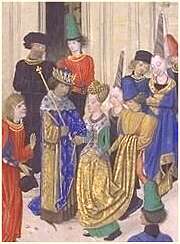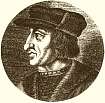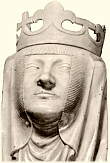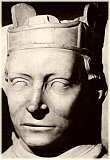Charles VI of France became King at the age of 12. He was a dreamy, sentimental, agreeable and pleasure-loving young man. Soon his uncles, the Dukes of Anjou, Berry, Burgundy and Bourbon, took over the government, raised taxes and plundered the treasury. The Hundred Years War against England had left France short of funds and in 1382 revolts broke out in many parts of France. In 1388 Charles, aided by his bother Louis of Orléans (1371-1407), removed his uncles from power and replaced them with a group of his father's councillors of humble origins.
 In 1385 the beautiful Bavarian Princess Isabeau (1371-1435) had been sent to France
to become Charles' bride. For 16-year-old Charles it was love at first sight.
He could not take his eyes off her and he arranged for the marriage
to take place immediately because he could hardly sleep till the marriage was
consummated. The attraction was only physical to begin with, because she did not speak
French, and he did not understand German. The first years of their marriage were happy and
the young couple held lavish festivities lasting for days. Charles VI was taller than
average with a broad chest and he was a good horseman and a skilled archer. He was
affable, liberal, generous and kind and used to greet even lowly people. The sensual
Isabeau, however, soon turned out to be a frivolous and selfish woman. All she wanted from
life was to have enough means to have her desires fulfilled. She had no real interest in
France and never bothered to speak French well.
In 1385 the beautiful Bavarian Princess Isabeau (1371-1435) had been sent to France
to become Charles' bride. For 16-year-old Charles it was love at first sight.
He could not take his eyes off her and he arranged for the marriage
to take place immediately because he could hardly sleep till the marriage was
consummated. The attraction was only physical to begin with, because she did not speak
French, and he did not understand German. The first years of their marriage were happy and
the young couple held lavish festivities lasting for days. Charles VI was taller than
average with a broad chest and he was a good horseman and a skilled archer. He was
affable, liberal, generous and kind and used to greet even lowly people. The sensual
Isabeau, however, soon turned out to be a frivolous and selfish woman. All she wanted from
life was to have enough means to have her desires fulfilled. She had no real interest in
France and never bothered to speak French well. In April 1392 Charles suffered from a mysterious illness which caused his hair and nails to fall out. He was hardly recovered, still suffering from occasional bouts of fever and behaving incoherently, when he set out on a punitive expedition after an assassination attempt on one of his advisors. On a hot day in August Charles rode at the head of a group of knights, when a wild-looking man ran up to his horse and spoke some words of doom and betrayal. While they continued their journey, a page accidentally dropped a lance. Suddenly Charles rushed forward with a drawn sword and killed 4 of his own men before he could be overpowered. Lifted from his horse, Charles lay flat and speechless on the ground, his eyes rolling wildly from side to side. His attendants found an ox-cart to carry him. For two days Charles was in a coma. With the help of a physician, Guillaume de Harcigny, he made a partial recovery. When Charles heard that he had killed four of his own men, he wept. From then on his mental health was seriously undermined.
On January 28, 1393 the Queen gave a ball masque and Charles VI and a group of his courtiers dressed up like 'wild men' in linen costumes. They were accidentally set alight by a torch and four of them burned alive. Charles was saved by the Duchess of Berry, who threw her voluminous skirts over him. Queen Isabeau fainted in terror. Nevertheless, the accident made a deep impression on Charles and in June he was in the grip of another serious attack of insanity. A surgeon drilled some holes in Charles' skull, hoping to relieve pressure on his brain. Although Charles felt some momentary relief after the operation, he suffered a relapse in 1395. In 1397 Charles became aware that his brain was clouding again and requested to have his dagger removed. Some churchmen and university doctors came to believe that Charles was the victim of sorcery and around 1398 some attempts were made to exorcise him. Once Charles cried out: "If there is any one of you who is an accomplice in this evil I suffer, I beg him to torture me no longer but let me die!"
 Charles' attacks of insanity became more frequent and of longer duration.
Still, there were intervals of months during which Charles was sane except for the uncertainty of his temper, alternating between passive listlessness and excitable gaiety.
During the attacks Charles had delusions, claiming that his name was Georges, denying that he was the King or had a wife or any children.
He ran from room to room until he collapsed from exhaustion, wailing that his enemies were upon him.
Later, when he was kept in dark and closely shuttered apartments, he attacked with maniacal fury any servants or doctors who attempted to enter.
He smashed the furniture and urinated in his clothes.
In their own apartments, Charles' youngest daughters could hear their father's wailing and screaming.
On one occasion, Charles regained his senses unexpectedly and was stricken with horror at his own condition,
and even more so when he saw the misery of his daughters. He immediately ordered a gold goblet to be sold to buy suitable clothes for them.
Later, Charles went through a stage of believing that he was made of glass 1 and that if people came too near him he would break.
Thus he insisted that iron rods should be inserted into his clothing to prevent him from breaking.
Charles' attacks of insanity became more frequent and of longer duration.
Still, there were intervals of months during which Charles was sane except for the uncertainty of his temper, alternating between passive listlessness and excitable gaiety.
During the attacks Charles had delusions, claiming that his name was Georges, denying that he was the King or had a wife or any children.
He ran from room to room until he collapsed from exhaustion, wailing that his enemies were upon him.
Later, when he was kept in dark and closely shuttered apartments, he attacked with maniacal fury any servants or doctors who attempted to enter.
He smashed the furniture and urinated in his clothes.
In their own apartments, Charles' youngest daughters could hear their father's wailing and screaming.
On one occasion, Charles regained his senses unexpectedly and was stricken with horror at his own condition,
and even more so when he saw the misery of his daughters. He immediately ordered a gold goblet to be sold to buy suitable clothes for them.
Later, Charles went through a stage of believing that he was made of glass 1 and that if people came too near him he would break.
Thus he insisted that iron rods should be inserted into his clothing to prevent him from breaking. For some months in 1405 Charles refused to change his linen, to bathe or to be shaved, and as a consequence he was afflicted by skin trouble and lice. His physicians hoped to cure Charles with shock treatment. They arranged for some men to blacken their faces and hide in his room. When the King entered they all jumped out, presumably shouting: "boo". As a result Charles agreed to be washed, shaved and dressed and for a few weeks his behaviour was more reasonable.
On behalf of the succession the beautiful Isabeau continued to submit to the embraces of her mad husband until 1407. Charles' attitude to Isabeau show the ambivalent characteristics of schizophrenia; in his derangement Charles felt a strong resentment to his once beloved wife. His wild lusts often kept Isabeau in fear for her life and thus she arranged for a pretty young girl, Odette de Champdivers, to take her place. Meanwhile, voluptuous Isabeau found consolation in the arms of her debonair brother-in-law, Louis of Orléans (1371-1407)2. From the moment Isabeau had set foot in France, this elegant, ambitious and dissolute youth had been pursuing her. Soon they went everywhere together, often for weeks at a time, flagrantly enjoying themselves. The legitimacy of Isabeau's younger children was doubted and her relationship with Louis was at its height when Young Charles (1403-1461) was born. Isabeau lavished more care upon this puny and sickly 11th child than on the others.
While his body remained healthy, Charles VI was soon unable to concentrate, make decisions or govern at all. Even in his more lucid moments he did whatever those who were with him told him to do, so French politics became a rivalry for the ear of the King. A fierce power struggle developed between Louis of Orléans and John "the Fearless" of Burgundy (1371-1419)3 until John instigated the murder of Louis in November 1407. The Queen, who had recently lost her 12th child shortly after its birth, openly joined the party of her lover's murderers and soon became best friends with John the Fearless. The Duke was now opposed by Count Bernard VII of Armagnac (±1362-1418), who married his daughter to the Orléans heir, and the power struggle intensified with both parties massacring their enemies. When King Henry V of England (1387-1422) invaded France in 1415, his exhausted force of 5000 men defeated a French army five times its size in the famous Battle of Agincourt.
 At Vincennes, Queen Isabeau lived with her pets4
and was free to do as she chose. In the course of years, she had become abnormally fat.
Suffering from gout, she was unable to get around without a wheelchair. She had also developed a phobia of open spaces.
Bernard of Armagnac guarded the interests of her children and, when he found out that Isabeau was plotting with the Duke of Burgundy, he took revenge by informing the King - during one of his periods of comparative sanity - about the Queen's dissolute behaviour.
Spurred on by his heir, Young Charles, Charles VI actually decided to make a stand and rode with his son and the Count of Armagnac to Vincennes
to arrest the Queen's supposed latest lover, Louis de Boisbourdon. He was tortured, strangled and thrown into the Seine in a leather sack.
Isabeau was banished to Tours, officially for the "dissolute behaviour of her ladies-in-waiting",
but it is likely that they mainly blamed the Queen herself. Although kept under strickt guard,
Isabeau remained on good terms with John the Fearless, who had her released by 1418 and brought to Chartres.
Soon afterwards, her new favourite, Jean de Villiers, murdered Bernard of Armagnac and carved the cross of Burgundy on his chest.
At Vincennes, Queen Isabeau lived with her pets4
and was free to do as she chose. In the course of years, she had become abnormally fat.
Suffering from gout, she was unable to get around without a wheelchair. She had also developed a phobia of open spaces.
Bernard of Armagnac guarded the interests of her children and, when he found out that Isabeau was plotting with the Duke of Burgundy, he took revenge by informing the King - during one of his periods of comparative sanity - about the Queen's dissolute behaviour.
Spurred on by his heir, Young Charles, Charles VI actually decided to make a stand and rode with his son and the Count of Armagnac to Vincennes
to arrest the Queen's supposed latest lover, Louis de Boisbourdon. He was tortured, strangled and thrown into the Seine in a leather sack.
Isabeau was banished to Tours, officially for the "dissolute behaviour of her ladies-in-waiting",
but it is likely that they mainly blamed the Queen herself. Although kept under strickt guard,
Isabeau remained on good terms with John the Fearless, who had her released by 1418 and brought to Chartres.
Soon afterwards, her new favourite, Jean de Villiers, murdered Bernard of Armagnac and carved the cross of Burgundy on his chest.  In 1419 the 16-year-old heir to the throne was discredited, when John the Fearless was hacked to death at a meeting with him.
In return for a pension, Queen Isabeau disinherited the Crown Prince, "Charles, who calls himself the Dauphin".
She gave her daughter Catherine (1401-1438) in marriage to Henry V of England, the victor of Azincourt, and
recognised them as heirs to the throne. Henry V brought Charles VI, who had been living in
a state of neglect at Senlis, back to Paris. There he was taken ill with fever in 1421. He
recovered after eating enormous quantities of oranges and pomegranates. In the autumn of
1422 he fell ill again and with only strangers at hand he died. Henry V had died the same
year and Henry's baby son was crowned King Henry VI (1421-1471) of both England and
France.
In 1419 the 16-year-old heir to the throne was discredited, when John the Fearless was hacked to death at a meeting with him.
In return for a pension, Queen Isabeau disinherited the Crown Prince, "Charles, who calls himself the Dauphin".
She gave her daughter Catherine (1401-1438) in marriage to Henry V of England, the victor of Azincourt, and
recognised them as heirs to the throne. Henry V brought Charles VI, who had been living in
a state of neglect at Senlis, back to Paris. There he was taken ill with fever in 1421. He
recovered after eating enormous quantities of oranges and pomegranates. In the autumn of
1422 he fell ill again and with only strangers at hand he died. Henry V had died the same
year and Henry's baby son was crowned King Henry VI (1421-1471) of both England and
France. Charles' mysterious illness of 1392 could have been typhus or encephalitis. If this disease was encephalitis, then it could very likely have been a contributory factor to the bizarre features of Charles' behaviour, for encephalitis can cause a marked character change and give rise to impulsive, aggressive and intemperate activity, similar in its symptoms to those of schizophrenia.
The disease porphyria is another possible diagnose. Although few medical details regarding Charles VI are known to us, porphyria has been diagnosed among his ancestors5. It is a rare hereditary disease with many painful physical symptoms, like an inflammation of the bowels, a painful weakness of the limbs and sometimes loss of the power of feeling. Severe attacks can result in visual and auditory disturbances, delirium and progressive senility.
 Charles' immediate ancestors were closely
related to each other. His mother was the French Princess Joan of Bourbon (1338-1377, to
the left). Like her brother, father and grandfather, Joan was slightly unstable; "elle
en perdi son bon sens et son bon memore". She suffered a complete nervous
breakdown in 1373 after the birth of her 7th child. At the age of 12 Joan
had been married to Charles V "the Wise" of France (1337-1380), who was "racked
with gout"6 in his hands and feet and died
at the age of 43. Charles VI could have inherited bad genes from both his parents.
Charles' immediate ancestors were closely
related to each other. His mother was the French Princess Joan of Bourbon (1338-1377, to
the left). Like her brother, father and grandfather, Joan was slightly unstable; "elle
en perdi son bon sens et son bon memore". She suffered a complete nervous
breakdown in 1373 after the birth of her 7th child. At the age of 12 Joan
had been married to Charles V "the Wise" of France (1337-1380), who was "racked
with gout"6 in his hands and feet and died
at the age of 43. Charles VI could have inherited bad genes from both his parents. The mental capabilities of mad Charles' eldest son, Louis of Guyenne (1397-1415), were also questioned. He was a dissolute youth who spent his nights in revels and his days recovering from them. He and his brother John of Touraine (1398-1417) both died young and under mysterious circumstances. Charles' successor, Charles VII, was inconsistent, capricious, irresponsible, suspicious, fearful of assassination attempts and very insecure. He had a phobia for bridges after John the Fearless had been murdered on a bridge in his presence. Some weeks before his death Charles VII had a psychotic reaction, refusing all food. One of mad Charles' daughters, Michelle (1395-1422), became melancholic in 1419 following the involvement of her brother in the murder of her father-in-law, John the Fearless. The daughter who married Henry V may have introduced the disease porphyria into the British Royal family. Her eldest son, Henry VI of England and France, went mad, too, losing both his French and English possessions; her son by a Welsh lover was an ancestor of the Tudors and Stuarts.